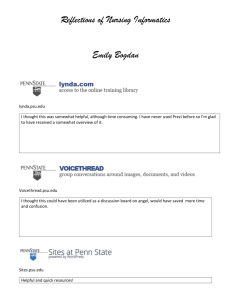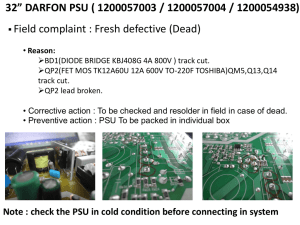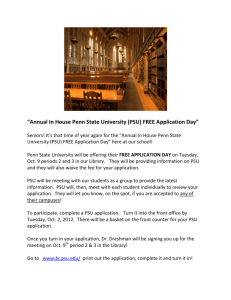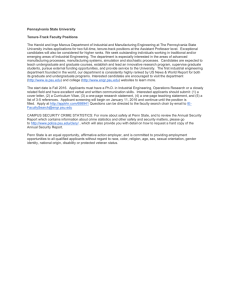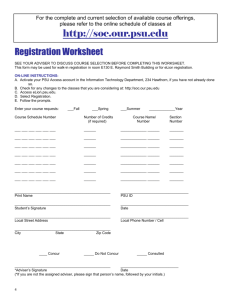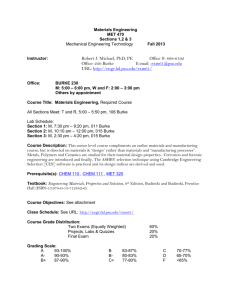Syllabus - School of Engineering
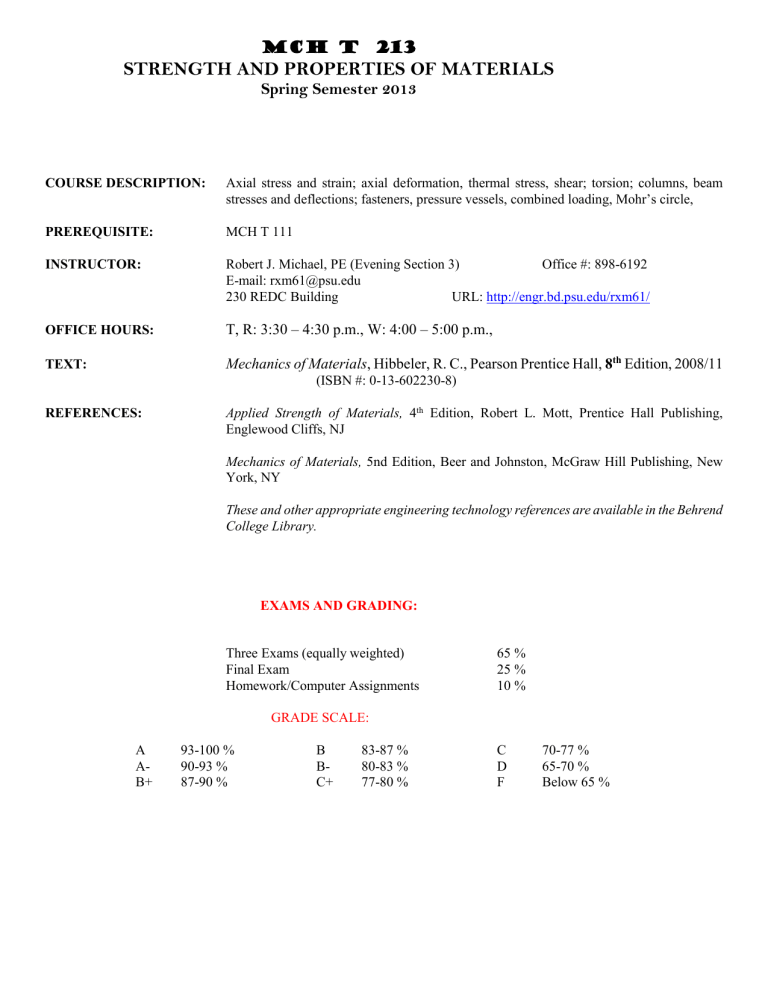
MCH T 213
STRENGTH AND PROPERTIES OF MATERIALS
Spring Semester 2013
COURSE DESCRIPTION: Axial stress and strain; axial deformation, thermal stress, shear; torsion; columns, beam stresses and deflections; fasteners, pressure vessels, combined loading, Mohr’s circle,
PREREQUISITE: MCH T 111
INSTRUCTOR: Robert J. Michael, PE (Evening Section 3)
E-mail: rxm61@psu.edu
230 REDC Building URL:
Office #: 898-6192 http://engr.bd.psu.edu/rxm61/
OFFICE HOURS: T, R: 3:30 – 4:30 p.m., W: 4:00 – 5:00 p.m.,
TEXT:
Mechanics of Materials
, Hibbeler, R. C., Pearson Prentice Hall, 8 th
Edition, 2008/11
(ISBN #: 0-13-602230-8)
REFERENCES: Applied Strength of Materials, 4 th Edition, Robert L. Mott, Prentice Hall Publishing,
Englewood Cliffs, NJ
Mechanics of Materials, 5nd Edition, Beer and Johnston, McGraw Hill Publishing, New
York, NY
These and other appropriate engineering technology references are available in the Behrend
College Library.
EXAMS AND GRADING:
Three Exams (equally weighted)
Final Exam
Homework/Computer Assignments
65 %
25 %
10 %
A 93-100 %
A- 90-93 %
B+ 87-90 %
GRADE SCALE:
B 83-87 %
B- 80-83 %
C+ 77-80 %
C
D
F
70-77 %
65-70 %
Below 65 %
HOMEWORK GUIDELINES:
Only a small sampling of problems from the homework assignments will be collected and graded. The problems to be collected will be selected on a random basis and announced at the time homework is due. The date that homework is due will be announced at least one class period in advance. Often, the class period before homework is due will be used to answer questions on the assignment to be collected. For assignments labeled as ‘homework’, collaboration is allowed. For assignments labeled as ‘quiz’, whether they be in-class or take-home, collaboration is not allowed and any evidence of such will be treated as academic dishonesty.
1.
Occasionally, an additional problem will be assigned, which will be collected and graded.
2.
Homework must be done on Engineering Calculation paper. Where applicable, free body diagrams should be included. Use a straight edge or paper grid to draw clear, concise free body diagrams. Proper SF and units should be used at all times.
3.
Multiple problems per page are permissible provided that: a) a given problem, requiring less than one page, does not start and end on different pages b) the start and end of a given problem are clearly defined
4.
Number all pages and put your name on every page. The first page title block should look like this:
MCHT 213 –Sect__ Hw #1: 1-1 to 15, 29, 37, etc Your Name Pg 1/__
5.
Work neatly . If I can’t read it, or if I have trouble following the flow of the solution, it will be marked wrong.
6.
Follow HW format: Problem #: Given: Find: Solution: (include FBD)
GENERAL COMMENTS:
- Attendance Policy: “A student should attend every class for which the student is scheduled and should be held responsible for all work covered in the courses taken." Significant (3 or more) unexcused absence may result in half a letter grade reduction. Students who fail to attend will not generally be allowed to make up quizzes or exams unless a prior arrangement has been made. Absences such as athletics travel notice, ROTC notice, family emergencies, etc., must be supported by written documentation prior to class. Note that in case of illness the student is responsible to notify the instructor before the class begins and to show evidence that medical attention was obtained. (See Policies and Rules for
Students on the PSU website at http://www.psu.edu/ufs/policies )
- Makeup Policy: Quizzes will be made up only if the makeup is arranged before the scheduled quiz period, and only in the case of an excused emergency.
- Academic Integrity: Penn State Erie puts a very high value on academic integrity, and violations are not tolerated.
Academic integrity is one of Penn State’s four principles to which all students must abide. Any violation of academic integrity will receive academic and possible disciplinary sanctions, including the possible awarding of an XF grade which is recorded on the transcript and states that failure of the course was due to an act of academic dishonesty. All acts of academic dishonesty are recorded so repeat offenders can be sanctioned accordingly. Students are encouraged to review more information on academic integrity which can be found at: http://www.pserie.psu.edu/faculty/academics/integrity.htm
- Cell phones have become a growing problem in schools , considered nuisance items because of classroom disruptions.
Please turn off cell phones while in class and absolutely no text messaging allowed during lectures. Failure to comply will result in an absence from class. Three or more unexcused absences may result in half a letter grade reduction for your final grade.
- Support Services:
Learning Resource Center: http://pennstatebehrend.psu.edu/academic/lrc/index.htm
Library: http://www.behrend.psu.edu/academic/library/index.htm
Computer Center: http://www.behrend.psu.edu/compcntr/compindex.htm
- General Policies, Rules & Procedures: http://www.sa.psu.edu/ja/procedures.shtml
Note to students with disabilities: Penn State welcomes students with disabilities into the University's educational programs. If you have a disability-related need for modifications or reasonable accommodations in this course, contact the
Disability Specialist in the Office of Student Affairs, Room 115 Reed Union Building, 898-6111.
- Relationship of course to program outcomes: MCH T 213 contributes to the following MET baccalaureate degree program outcomes:
[1] Students should be able to identify, analyze, and solve technical problems in the areas of materials, manufacturing processes, mechanics, strength of materials, and in the fluid and thermal sciences.
[2] Students should be able to use appropriate computer technologies during the solution of applied engineering problems
[3] Students should be able to integrate the basic CAD systems, manufacturing knowledge, and design techniques needed for successful product realization
[5] Students should be able to identify and use appropriate methods to validate solutions to engineering problems.
[8] Students should be able to identify social, economic, safety, quality, reliability, and ethical issues in an engineering technology problem and demonstrate that their solution to the problem addresses these issues.
- Course Objectives: After completing this course, students should be able to:
1.
Determine the internal reactions of rigid, static members.
2.
Identify and determine normal, shear, and bearing stresses from direct loadings on a member.
3.
Understand and use the relationships of stress, strain, elastic modulus, Poisson’s Ratio, material strengths and factors of safety to analyze and design simple members.
4.
Determine thermal expansion/contraction and/or thermal stresses when analyzing and designing members.
5.
Analyze and design circular shafting based on angular twist.
6.
Analyze and design simple, thin-walled spherical and cylindrical pressure vessels.
7.
Determine beam stresses and beam deflections and safely design beams for strength and stiffness requirements.
8.
Draw shear and moment diagrams.
9.
Analyze beams for transverse shear.
10.
Analyze and safely design simple columns with minor/major axis bracing.
11.
Analyze and safely design joints and fasteners.
12.
Determine stresses from 2-D combined loadings and use stress elements to represent the results.
13.
Determine principle stresses and maximum shear stress from 2-D combined loadings and use Mohr?s Circle to determine orientations of the principle stress element and the maximum shear stress element.
14.
Use hand calculations to verify a project using a spreadsheet program.
